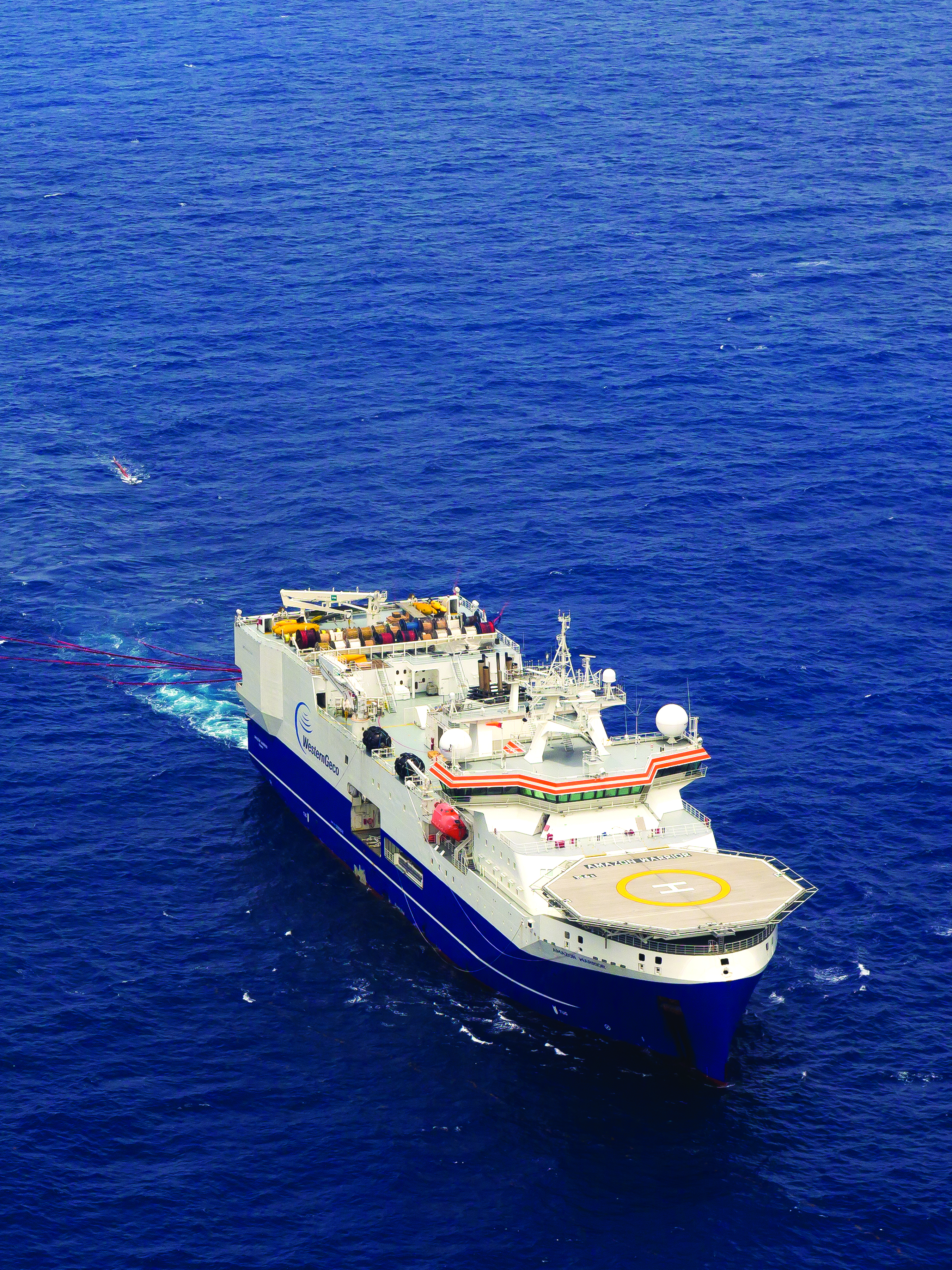Back in 1930, the founders of SEG would have known many of the basic principles required for accurate subsurface imaging, but limitations in acquisition, processing and interpretation systems forced major compromises. Over the years, recording hardware and computer technology have evolved to overcome many of these compromises, enabling more accurate sampling of seismic wavefields and resulting in increasingly reliable earth models.
Applying modern seismic technology, Schlumberger is acquiring long-offset wide-azimuth 3-D data over an area of about 80,000 sq km (31,250 sq miles) in the Campeche Basin using eight WesternGeco vessels divided into two fleets. Each fleet is deploying four seismic sources and recording data with up to 28 streamers, each of which is 9 km (5.623 miles) long. The two fleets have covered as much as 150 sq km (60 sq miles) per day.
The multiclient survey—designed to address imaging challenges including near-salt and subsalt structures, complex faulted structures and deep-thrusted structures—is being acquired using Q-Marine Solid streamers with a nonfluid-fill technology. Until recently, most streamers contained hydrocarbon fluids to provide buoyancy; however, in the event of damage such as shark bites, which are quite common, this can lead to leakage. By comparison, solid streamers are more environmentally friendly, have higher resistance to physical damage and are recognized as delivering good low-frequency signal-to-noise ratio. The Q-Marine point-receiver marine seismic system leverages advances in electronics and fiber-optic networks to provide high channel-count recording. Data are sampled at 3.13-m (10.25-ft) intervals along each streamer, enabling finely sampled recording of both signal and noise in the seismic wavefield. Shell geophysicists documented the potential of the single-sensor method in the late 1980s, but limitations in hardware and processing capabilities at the time prevented full realization of its benefits. Adequate sampling of streamer noise allows targeted signal-processing techniques to suppress it while preserving the integrity of the seismic signal. This effective noise removal allows acquisition of high-quality seismic data even in poor weather or when towing streamers through strong currents.
One of the vessels acquiring the new dataset is Amazon Warrior, the world’s first vessel designed from the bottom up to deliver optimum performance during seismic operations. Until now, seismic companies have identified various types of existing hull designs they considered suitable for their operations and converted the top decks to accommodate and deploy the specialized equipment. A feature common to all of these hull designs is that they were originally optimized for another purpose, which in most cases was to enable economic transit from one seaport to another at high cruising speeds. Efficient acquisition of high-quality marine seismic data not only requires deployment of large spreads of specialized in-sea equipment but also cost-effectiveness at the normal production speed of 5 knots, which on average represents about 80% of a vessel’s time at sea. Amazon-class vessels are designed with a hull, propulsion system and all the other components required to optimally meet the seismic requirements while also maximizing HSE performance and operational efficiency. Amazon Warrior currently is towing 14 streamers at 100-m (328-ft) separation and recording 40,320 seismic traces per shot. By comparison, surveys in the 1980s typically recorded just 96 to 120 traces per shot.

Recommended Reading
Oxy’s Stratos Direct Air Capture Project Nears Finish Line
2025-02-20 - Stratos Phase 1 is 94% complete overall and 98% complete on construction, Occidental Petroleum says.
California Resources Continues to Curb Emissions, This Time Using CCS for Cement
2025-03-04 - California Resources’ carbon management business Carbon TerraVault plans to break ground on its first CCS project in second-quarter 2025.
BKV Reaches FID, Forms Midstream Partnership for Eagle Ford CCS Project
2025-02-13 - If all required permits are secured, BKV’s CCS project in the Eagle Ford Shale will begin full operations in first-quarter 2026, the Barnett natural gas producer says.
CF Industries Form JV to Build $4B Low-Carbon Ammonia Project in Louisiana
2025-04-08 - CF Industries has reached a FID with JERA and Mitsui for an ammonia production facility in Louisiana. CF Industries sealed a deal with Occidental’s 1PointFive to capture and store CO2 from the facility.
Cella Mixes Two Approaches to Keep CO2 Solidly Underground
2025-04-01 - Cella, a startup in partnership with Halliburton, injects CO2 into basaltic reservoirs, where it reacts and hardens.
Comments
Add new comment
This conversation is moderated according to Hart Energy community rules. Please read the rules before joining the discussion. If you’re experiencing any technical problems, please contact our customer care team.





